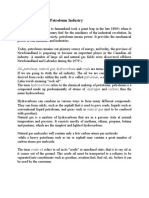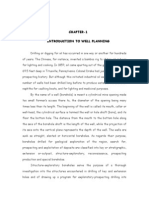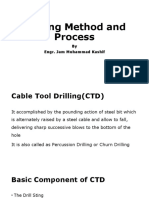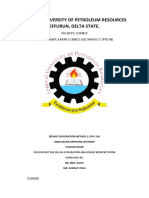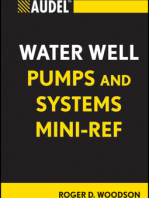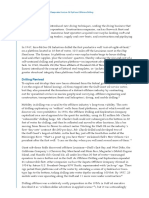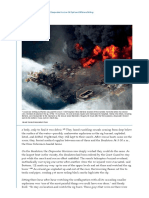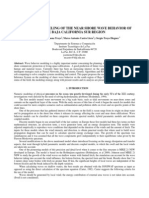0 ratings0% found this document useful (0 votes)
231 viewsDrilling Rot
Drilling Rot
Uploaded by
HELPPPPPRotary drilling uses a rotating drill bit to bore down through the earth's crust. While the concept has existed for thousands of years, rotary drilling did not become widely used until the early 1900s. A rotary drilling rig consists of four main components - prime movers to power the rig, hoisting equipment to raise and lower the drill string, rotating equipment to spin the drill bit, and circulating equipment to pump fluid down the drill pipe. Modern rotary drilling techniques allow oil and gas wells to be drilled to great depths worldwide.
Copyright:
© All Rights Reserved
Available Formats
Download as PDF, TXT or read online from Scribd
Drilling Rot
Drilling Rot
Uploaded by
HELPPPPP0 ratings0% found this document useful (0 votes)
231 views5 pagesRotary drilling uses a rotating drill bit to bore down through the earth's crust. While the concept has existed for thousands of years, rotary drilling did not become widely used until the early 1900s. A rotary drilling rig consists of four main components - prime movers to power the rig, hoisting equipment to raise and lower the drill string, rotating equipment to spin the drill bit, and circulating equipment to pump fluid down the drill pipe. Modern rotary drilling techniques allow oil and gas wells to be drilled to great depths worldwide.
Original Description:
drill
Copyright
© © All Rights Reserved
Available Formats
PDF, TXT or read online from Scribd
Share this document
Did you find this document useful?
Is this content inappropriate?
Rotary drilling uses a rotating drill bit to bore down through the earth's crust. While the concept has existed for thousands of years, rotary drilling did not become widely used until the early 1900s. A rotary drilling rig consists of four main components - prime movers to power the rig, hoisting equipment to raise and lower the drill string, rotating equipment to spin the drill bit, and circulating equipment to pump fluid down the drill pipe. Modern rotary drilling techniques allow oil and gas wells to be drilled to great depths worldwide.
Copyright:
© All Rights Reserved
Available Formats
Download as PDF, TXT or read online from Scribd
Download as pdf or txt
0 ratings0% found this document useful (0 votes)
231 views5 pagesDrilling Rot
Drilling Rot
Uploaded by
HELPPPPPRotary drilling uses a rotating drill bit to bore down through the earth's crust. While the concept has existed for thousands of years, rotary drilling did not become widely used until the early 1900s. A rotary drilling rig consists of four main components - prime movers to power the rig, hoisting equipment to raise and lower the drill string, rotating equipment to spin the drill bit, and circulating equipment to pump fluid down the drill pipe. Modern rotary drilling techniques allow oil and gas wells to be drilled to great depths worldwide.
Copyright:
© All Rights Reserved
Available Formats
Download as PDF, TXT or read online from Scribd
Download as pdf or txt
You are on page 1of 5
Rotary drilling uses a sharp, rotating drill bit to dig down
through the Earth's crust. Much like a common hand
held drill, the spinning of the drill bit allows for
penetration of even the hardest rock. The idea of using a
rotary drill bit is not new.
Archeological records show that as early as 3000 B.C.,
the Egyptians may have been using a similar technique.
Leonardo Di Vinci, as early as 1500, developed a design
for a rotary drilling mechanism that bears much
resemblance to technology used today. Despite these
precursors, rotary drilling did not rise in use or
popularity until the early 1900's.
Although rotary drilling techniques had been patented
as early as 1833, most of these early attempts at rotary
drilling consisted of little more than a mule, attached to
a drilling device, walking in a circle! It was the success
of the efforts of Captain Anthony Lucas and Patillo
Higgins in drilling their 1901 'Spindletop' well in Texas
that catapulted rotary drilling to the forefront of
petroleum drilling technology.
While the concept for rotary drilling - using a sharp,
spinning drill bit to delve into rock - is quite simple, the
actual mechanics of modern rigs are quite complicated.
In addition, technology advances so rapidly that new
innovations are being introduced constantly. The basic
rotary drilling system consists of four groups of
components. The prime movers, hoisting equipment,
rotating equipment, and circulating equipment all
combine to make rotary drilling possible.
1. Prime Movers
The prime movers in a rotary drilling rig are those
pieces of equipment that provide the power to the entire
rig. Steam engines provided the power to the early drill
rigs. Gas and diesel engines became the norm after
World War II.
Recently, while diesel engines still compose the
majority of power sources on rotary rigs, other types of
engines are also in use; more so in the oil and gas
industry than in the water well sector. Natural gas or
gasoline engines are commonly used, as are natural gas
or gasoline powered reciprocating turbines, which
generate electricity on site. The resulting electricity is
used to power the rig itself. The energy from these
prime movers is used to power the rotary equipment,
the hoisting equipment, and the circulating equipment,
and on large rigs may be used as well to provide
incidental lighting, water, and compression
requirements not associated directly with drilling.
2. Hoisting Equipment
The hoisting equipment on a rotary rig consists of the
tools used to raise and lower whatever other equipment
may go into or come out of the well. The most visible
part of the hoisting equipment is the derrick, the tall
tower-like structure that extends vertically from the well
hole. This structure serves as a support for the cables
(drilling lines) and pulleys (draw works) that serve to
lower or raise the equipment in the well.
For instance, in rotary drilling, the wells are dug with
long strings of pipe (drill pipe) extending from the
surface down to the drill bit. If a drill bit needs to be
changed, either due to wear and tear or a change in the
subsurface rock, the whole string of pipe must be raised
to the surface. In deep wells, the combined weight of the
drill pipe, drill bit, and drill collars (thicker drill pipe
located just above the bit) may be in excess of
thousands of pounds. The hoisting equipment is used to
raise all of this equipment to the surface so that the drill
bit may be replaced, at which point the entire chain of
drill pipe is lowered back into the well.
The height of a rigs derrick can often be a clue as to the
depth of the well being dug. Drill pipe traditionally
comes in 20ft sections, which are joined together as the
well is dug deeper and deeper. This means that even if a
well is 1200 feet deep, the drill string must still be taken
out in 20 foot sections. However, if the derrick is tall
enough, multiple joints of drill pipe may be removed at
once, speeding up the process a great deal.
3. Rotating Equipment
The rotating equipment on a rotary drilling rig consists
of the components that actually serve to rotate the drill
bit, which in turn digs the hole deeper and deeper into
the ground. The rotating equipment consists of a
number of different parts, all of which contribute to
transferring power from the prime mover to the drill bit
itself. The prime mover supplies power to the rotary,
which is the device that turns the drill pipe, which in
turn is attached to the drill bit. A component called the
swivel, which is attached to the hoisting equipment,
carries the entire weight of the drill string, but allows it
to rotate freely.
The drill pipe (which, when joined together, forms the
drill string) consists of 20ft sections of heavy steel pipe.
The pipes are threaded so that they can interlock
together. Drill pipe is manufactured to meet
specifications laid out by the American Petroleum
Institute (API), and others, which allows for a certain
degree of homogeneity for drill pipes across the
industry.
Below the drill pipe are drill collars, which are heavier,
thicker, and stronger than normal drill pipe. The drill
collars help to add weight to the drill string, right above
the bit, to ensure there is enough downward pressure to
allow the bit to drill through hard rock. The number and
nature of the drill collars on any particular rotary rig can
be altered depending on the down hole conditions
experienced while drilling.
Rotary Drill Bits
The drill bit is located at the bottom end of the drill
string, and is responsible for actually making contact
with the subsurface layers, and drilling through them.
The drill bit is responsible for breaking up and
dislodging rock, sediment, and anything else that may
be encountered while drilling. There are dozens of
different drill bit types, each designed for different
subsurface drilling conditions. Different rock layers
experienced during drilling may require the use of
different drill bits to achieve maximum drilling
efficiency. It can be a long process to change bits, due
to the fact that the whole drill string must be removed;
but using the correct drill bit, or replacing a worn bit,
can save a great deal of time during drilling. Drill bits are
chosen given the underground formations expected to
be encountered.
There are four main types of drill bits, each suited for
particular conditions.
You might also like
- Rig IntroductionDocument214 pagesRig IntroductionAnonymous 1pblc2Y100% (11)
- Coiled Tubing Operations at a Glance: What Do You Know About Coiled Tubing Operations!From EverandCoiled Tubing Operations at a Glance: What Do You Know About Coiled Tubing Operations!Rating: 5 out of 5 stars5/5 (2)
- NWBC Link Is Not WorkingDocument3 pagesNWBC Link Is Not WorkingbossNo ratings yet
- Technical Data Schedule TRANSFORMER 60 MVA (50MVA), 132/33 KVDocument10 pagesTechnical Data Schedule TRANSFORMER 60 MVA (50MVA), 132/33 KVGboyega AwelewaNo ratings yet
- Drilling Rig: From Wikipedia, The Free EncyclopediaDocument13 pagesDrilling Rig: From Wikipedia, The Free EncyclopediaSoham DeNo ratings yet
- Boreholes Water Wells Natural GasDocument17 pagesBoreholes Water Wells Natural Gasjk.epro2762No ratings yet
- Drilling RigsDocument18 pagesDrilling RigsegyinspectoryahooNo ratings yet
- Exploratory Drilling Methods: Simple Diagram of A Drilling Rig and Its Basic OperationDocument12 pagesExploratory Drilling Methods: Simple Diagram of A Drilling Rig and Its Basic OperationArvind Mishra100% (1)
- 1 Drilling Rig C 1Document10 pages1 Drilling Rig C 1Rafael FuentesNo ratings yet
- Drilling EngineeringDocument23 pagesDrilling EngineeringckxlfxksldNo ratings yet
- Mobile Drilling RigsDocument18 pagesMobile Drilling RigsGonzalo Rial Muíños100% (2)
- Drilling PreliminariesDocument141 pagesDrilling PreliminariesMohammed Safuvan Kazhungil100% (1)
- OnshoreDocument11 pagesOnshorewwwauniiiiiNo ratings yet
- Introduction of Drilling Rig in Oil & Gas Indutry - WikipediaDocument12 pagesIntroduction of Drilling Rig in Oil & Gas Indutry - WikipediaFaiz AhmadNo ratings yet
- Production Cycles Unit Operation and Auxiliary Operation, Drilling Techniques, Blasting, Excavation, Loading, Haulage and HoistingDocument33 pagesProduction Cycles Unit Operation and Auxiliary Operation, Drilling Techniques, Blasting, Excavation, Loading, Haulage and HoistingSiraj BeyanNo ratings yet
- Principle to Petroleum Engineering5Document15 pagesPrinciple to Petroleum Engineering5zvqd2mdg5gNo ratings yet
- Introduction, Wellbores Types and Drilling MethodsDocument16 pagesIntroduction, Wellbores Types and Drilling MethodsSadeq Al-tmimiNo ratings yet
- Introduction To The Petroleum Industry: Oil, Petroleum, Natural Gas, Hydrocarbons and Crude Are Terms We Commonly HearDocument25 pagesIntroduction To The Petroleum Industry: Oil, Petroleum, Natural Gas, Hydrocarbons and Crude Are Terms We Commonly Hearزين العابدين هيثم لفته جابرNo ratings yet
- Guide To DrillingDocument9 pagesGuide To DrillingEhab AhmedNo ratings yet
- Drilling 1Document33 pagesDrilling 1OUMAIMA OULD SALTANANo ratings yet
- Lec 2 Intro To Drilling EngineeringDocument28 pagesLec 2 Intro To Drilling EngineeringNoumanIhsanNo ratings yet
- (Assign 2)Document17 pages(Assign 2)Shehzad khanNo ratings yet
- DRILLLING TechDocument131 pagesDRILLLING TechsiriuslotNo ratings yet
- Drilling Methods L N 2Document17 pagesDrilling Methods L N 2try20171111No ratings yet
- Drilling TchnologiesDocument42 pagesDrilling TchnologiesgeorgiadisgNo ratings yet
- Well Drilling Process: Philip Louis B. EstevezDocument77 pagesWell Drilling Process: Philip Louis B. EstevezLovely Mae Cruza Gawingan100% (1)
- Chapter (4) Drilling Methods and Type of RigsDocument26 pagesChapter (4) Drilling Methods and Type of RigsFarhat Mirza100% (1)
- Mod 2 DRLG BasicsDocument12 pagesMod 2 DRLG BasicsMin Thant MaungNo ratings yet
- Drilling Engineering 1Document51 pagesDrilling Engineering 1Adnan AhmadNo ratings yet
- Drilling RigDocument4 pagesDrilling RigDileep kumarNo ratings yet
- Drilling MethodsDocument50 pagesDrilling MethodsKhairul AshrafNo ratings yet
- 5 2019 01 14!11 06 50 PM PDFDocument10 pages5 2019 01 14!11 06 50 PM PDFchemsNo ratings yet
- Chapter-1 Introduction To Well PlanningDocument33 pagesChapter-1 Introduction To Well Planningsparda94No ratings yet
- DrillingDocument20 pagesDrillingnegi.ya.12No ratings yet
- Drill Pipe Drill StringDocument11 pagesDrill Pipe Drill StringRodrigoBernardo50% (2)
- Drilling A WellDocument100 pagesDrilling A Welldiganta kumarNo ratings yet
- Drilling Methods and Type of Rigs PDFDocument26 pagesDrilling Methods and Type of Rigs PDFnamdq-1100% (1)
- Unit Operations in MiningDocument10 pagesUnit Operations in MiningNaveenNo ratings yet
- Water Well Drilling MethodsDocument21 pagesWater Well Drilling MethodsAry Rachman100% (4)
- Lecture 3 - Drilling Methods and Process-1Document34 pagesLecture 3 - Drilling Methods and Process-1hasan sabah100% (2)
- Deep-Drilling EngineeringDocument2 pagesDeep-Drilling Engineeringsmithlee707No ratings yet
- Drilling Engineering Chapter 1Document41 pagesDrilling Engineering Chapter 1Wong Jin Yang100% (3)
- English Presentation-Drilling ProcessDocument4 pagesEnglish Presentation-Drilling ProcessbriceborisNo ratings yet
- Jaeger's GPH 314 REPORTDocument12 pagesJaeger's GPH 314 REPORTJames FieworNo ratings yet
- Rig RigDocument11 pagesRig Rigsseaea100% (3)
- Drilling NotesDocument42 pagesDrilling NotesephremNo ratings yet
- Drilling (Written Report)Document13 pagesDrilling (Written Report)ynacruzer09021996No ratings yet
- Water Drilling Method PDFDocument16 pagesWater Drilling Method PDFfajar andriannur azizyNo ratings yet
- Rotatry Drilling: Hydraulics Torque MastDocument8 pagesRotatry Drilling: Hydraulics Torque MastRakesh RoushanNo ratings yet
- A S T U D y o F F A I L U R e S I N E X C A V A T o R A R MDocument8 pagesA S T U D y o F F A I L U R e S I N E X C A V A T o R A R MSonyAcerNo ratings yet
- Drill StringDocument5 pagesDrill StringAliceAlormenuNo ratings yet
- Drill String On A Drilling Rig Is A ColumnDocument9 pagesDrill String On A Drilling Rig Is A ColumnETRNo ratings yet
- Water Well Drilling MethodsDocument16 pagesWater Well Drilling Methodsisaac_alcantara_glezNo ratings yet
- Basic Drilling EngineeringDocument26 pagesBasic Drilling EngineeringAhmedsharifMohammedNo ratings yet
- Rock Blasting - A Practical Treatise On The Means Employed In Blasting Rocks For Industrial PurposesFrom EverandRock Blasting - A Practical Treatise On The Means Employed In Blasting Rocks For Industrial PurposesNo ratings yet
- Rock Blasting: A Practical Treatise on the Means Employed in Blasting Rocks for Industrial PurposesFrom EverandRock Blasting: A Practical Treatise on the Means Employed in Blasting Rocks for Industrial PurposesNo ratings yet
- Windmills and Waterwheels Explained: What They Do and How They WorkFrom EverandWindmills and Waterwheels Explained: What They Do and How They WorkNo ratings yet
- Steam Turbines A Book of Instruction for the Adjustment and Operation of the Principal Types of this Class of Prime MoversFrom EverandSteam Turbines A Book of Instruction for the Adjustment and Operation of the Principal Types of this Class of Prime MoversRating: 5 out of 5 stars5/5 (2)
- Study Wellcontrol PDFDocument5 pagesStudy Wellcontrol PDFHELPPPPPNo ratings yet
- History of Onshore Oil Drilling PDFDocument3 pagesHistory of Onshore Oil Drilling PDFHELPPPPPNo ratings yet
- Wellcontrol StudyDocument5 pagesWellcontrol StudyHELPPPPPNo ratings yet
- Auger Tension Leg Plat FormDocument3 pagesAuger Tension Leg Plat FormHELPPPPPNo ratings yet
- BLOW OUT Report 3Document3 pagesBLOW OUT Report 3HELPPPPPNo ratings yet
- Try Some Yourself - . - Exercise 1.28: IWCF UK Branch Distance Learning Programme - DRILLING CALCULATIONSDocument2 pagesTry Some Yourself - . - Exercise 1.28: IWCF UK Branch Distance Learning Programme - DRILLING CALCULATIONSHELPPPPPNo ratings yet
- Necessary Zeros: Try Some Yourself - . - Exercise 1.27Document1 pageNecessary Zeros: Try Some Yourself - . - Exercise 1.27HELPPPPPNo ratings yet
- Polished Bore Receptacle and Seal Assembly: SchlumbergerDocument1 pagePolished Bore Receptacle and Seal Assembly: SchlumbergerHELPPPPPNo ratings yet
- Moccondo Full Well Report 1Document5 pagesMoccondo Full Well Report 1HELPPPPPNo ratings yet
- Polished Bore Receptacle and Seal Assembly: SchlumbergerDocument1 pagePolished Bore Receptacle and Seal Assembly: SchlumbergerHELPPPPPNo ratings yet
- Moccondo Full Well Report 1Document5 pagesMoccondo Full Well Report 1HELPPPPPNo ratings yet
- Design Manual Petroleum Oil GasDocument10 pagesDesign Manual Petroleum Oil GasHELPPPPPNo ratings yet
- Try Some Yourself - . - Exercise 1.28: IWCF UK Branch Distance Learning Programme - DRILLING CALCULATIONSDocument1 pageTry Some Yourself - . - Exercise 1.28: IWCF UK Branch Distance Learning Programme - DRILLING CALCULATIONSHELPPPPPNo ratings yet
- Distance Learning 76Document1 pageDistance Learning 76HELPPPPPNo ratings yet
- Try Some Yourself - . - Exercise 1.25: Using A Ruler or A ScaleDocument1 pageTry Some Yourself - . - Exercise 1.25: Using A Ruler or A ScaleHELPPPPPNo ratings yet
- Try Some Yourself - . - Exercise 1.25: Using A Ruler or A ScaleDocument2 pagesTry Some Yourself - . - Exercise 1.25: Using A Ruler or A ScaleHELPPPPPNo ratings yet
- Try Some Yourself Exercise 1.24 Continued: IWCF UK Branch Distance Learning Programme - DRILLING CALCULATIONSDocument2 pagesTry Some Yourself Exercise 1.24 Continued: IWCF UK Branch Distance Learning Programme - DRILLING CALCULATIONSHELPPPPPNo ratings yet
- 4.2: Decimals, Percentages and Ratios: IWCF UK Branch Distance Learning Programme - DRILLING CALCULATIONSDocument2 pages4.2: Decimals, Percentages and Ratios: IWCF UK Branch Distance Learning Programme - DRILLING CALCULATIONSHELPPPPPNo ratings yet
- Try Some Yourself Exercise 1.24 Continued: IWCF UK Branch Distance Learning Programme - DRILLING CALCULATIONSDocument3 pagesTry Some Yourself Exercise 1.24 Continued: IWCF UK Branch Distance Learning Programme - DRILLING CALCULATIONSHELPPPPPNo ratings yet
- Distance Learning 72Document3 pagesDistance Learning 72HELPPPPPNo ratings yet
- Mixed Fractions To Improper Fractions: Try Some Yourself - . - Exercise 1.21Document3 pagesMixed Fractions To Improper Fractions: Try Some Yourself - . - Exercise 1.21HELPPPPPNo ratings yet
- IWCF UK Branch Distance Learning Programme - DRILLING CALCULATIONSDocument2 pagesIWCF UK Branch Distance Learning Programme - DRILLING CALCULATIONSHELPPPPPNo ratings yet
- Distance Learning 67Document2 pagesDistance Learning 67HELPPPPPNo ratings yet
- Try Some Yourself - . - Exercise 1.22: IWCF UK Branch Distance Learning Programme - DRILLING CALCULATIONSDocument2 pagesTry Some Yourself - . - Exercise 1.22: IWCF UK Branch Distance Learning Programme - DRILLING CALCULATIONSHELPPPPPNo ratings yet
- Try Some Yourself - Exercise 1.18: 1. Sketch These Fractions 5Document3 pagesTry Some Yourself - Exercise 1.18: 1. Sketch These Fractions 5HELPPPPPNo ratings yet
- Distance Learning 62Document1 pageDistance Learning 62HELPPPPPNo ratings yet
- Distance Learning 66Document3 pagesDistance Learning 66HELPPPPPNo ratings yet
- Try Some Yourself - . - Exercise 1.23: IWCF UK Branch Distance Learning Programme - DRILLING CALCULATIONSDocument1 pageTry Some Yourself - . - Exercise 1.23: IWCF UK Branch Distance Learning Programme - DRILLING CALCULATIONSHELPPPPPNo ratings yet
- Try Some Yourself - . - Exercise 1.23: IWCF UK Branch Distance Learning Programme - DRILLING CALCULATIONSDocument1 pageTry Some Yourself - . - Exercise 1.23: IWCF UK Branch Distance Learning Programme - DRILLING CALCULATIONSHELPPPPPNo ratings yet
- Distance Learning 59Document1 pageDistance Learning 59HELPPPPPNo ratings yet
- GPU Programming: Dr. Florian FerreiraDocument101 pagesGPU Programming: Dr. Florian FerreiraSlal OpzaNo ratings yet
- USE61400-25 Conformance Testing Draft 2433 1697822974Document148 pagesUSE61400-25 Conformance Testing Draft 2433 1697822974yogaraj.amreshkNo ratings yet
- CV Zagane MohammedDocument4 pagesCV Zagane Mohammedsalah mohammedNo ratings yet
- Geometric and Negative Binomial DistributionDocument14 pagesGeometric and Negative Binomial DistributionASClabISBNo ratings yet
- FR-A800, Instruction ManualDocument1,042 pagesFR-A800, Instruction ManualspahhNo ratings yet
- Well History ReportDocument3 pagesWell History Reportsoheilvb6No ratings yet
- SAURE LEICA IWAA2018 Laser Tracker StandardsDocument10 pagesSAURE LEICA IWAA2018 Laser Tracker Standardscmm5477No ratings yet
- Mokveld-Brochure Axial On-Off enDocument16 pagesMokveld-Brochure Axial On-Off enteacg100% (1)
- Eng (A724 A728 Upgrade)Document10 pagesEng (A724 A728 Upgrade)Nelson AltuveNo ratings yet
- Syllabus CBA2 (1 To 8) FA 3 (9 To 10)Document5 pagesSyllabus CBA2 (1 To 8) FA 3 (9 To 10)Prem saiNo ratings yet
- Test Plan Document 2023Document10 pagesTest Plan Document 2023shivani varuNo ratings yet
- ATR Ata - 25 - Equipment - FurnishingDocument58 pagesATR Ata - 25 - Equipment - FurnishingJesús Montalvo FernándezNo ratings yet
- Chapter11-Nuclear ChemistryDocument52 pagesChapter11-Nuclear ChemistryfranantapurbaNo ratings yet
- Geothermal Energy in Indonesia - INAGA SCDocument8 pagesGeothermal Energy in Indonesia - INAGA SCImmanuel Lumban GaolNo ratings yet
- 01 Codeliterature Page Audit ReportDocument46 pages01 Codeliterature Page Audit ReportDivya KhannaNo ratings yet
- ACT1000 and ACT1000HF Linear ActuatorsDocument2 pagesACT1000 and ACT1000HF Linear ActuatorsivanNo ratings yet
- NTM 1 MokDocument10 pagesNTM 1 MokNick MaxNo ratings yet
- science-physics-year-11-spring-termDocument6 pagesscience-physics-year-11-spring-termAshwin VigneswaranNo ratings yet
- Questions 9: Dr. Roman Belavkin BIS4435Document7 pagesQuestions 9: Dr. Roman Belavkin BIS4435Amit MishraNo ratings yet
- Make It Home: Automatic Optimization of Furniture ArrangementDocument11 pagesMake It Home: Automatic Optimization of Furniture ArrangementTuan Huy LeNo ratings yet
- Alternating Current Previous Eapcet Physics - QPDocument18 pagesAlternating Current Previous Eapcet Physics - QPRama Mohana Rao BhandaruNo ratings yet
- Data Sheet: SCRD-V Cross Scored SeriesDocument2 pagesData Sheet: SCRD-V Cross Scored SeriesMustafa PardawalaNo ratings yet
- Cipitech 09Document6 pagesCipitech 09mmm_rcNo ratings yet
- Z FKK CRM Account PaymentDocument6 pagesZ FKK CRM Account PaymentJoe ReedNo ratings yet
- Modicon M340 For Ethernet Communications Modules and ProcessorsDocument382 pagesModicon M340 For Ethernet Communications Modules and ProcessorsRameez IrfanNo ratings yet
- Brame StressArabicGenerative 1971Document37 pagesBrame StressArabicGenerative 1971Cheman SangmaNo ratings yet
- Soft - Verif7thexam - Exam2021 2Document4 pagesSoft - Verif7thexam - Exam2021 2Melesiya AbdelmassiehNo ratings yet
- Catalogo Schiavi Macchine International 2019 ENDocument20 pagesCatalogo Schiavi Macchine International 2019 ENwaldy CamachoNo ratings yet

















